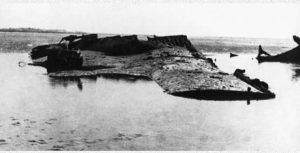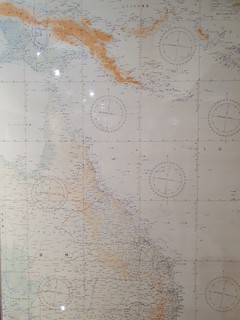A disastrous and emotional event that left deep scars in both the Netherlands and Australia was the bombing of Broome.
After the conquest of Timor, Australia was now in striking range of Japanese bombers. After Bali fell, Darwin was bombed by the Japanese on February 19th here they also destroyed several ships of KNIL Marine fleet.
Broome had become a major war port in northern Australia, as it was closest to Java. It had an airstrip as well as a suitable bay (Roebuck) that could be used by the flying boats.
After the Fall of Singapore, the Japanese moved on to NEI and Dutch, Australian and American aircraft started to shuttle refugees from Tjilatjap, Java to Broome. The estimated number of aerial evacuees from NEI passing through Broome at this time is estimated at around 1,350. Most of these were military personnel. There were approximately 250 Dutch civilian refugees, most of whom were family members of Dutch officials.


Transporting people from the flying boats – moored in the bay – to ‘terra firma’ could take some time and accommodation in Broome was overstretched, so many had to stay on board of the planes for several hours as well as overnight for those arriving late in the day.
Remarkably, none of those who stayed in the planes, nor those on land were alarmed when on March 2nd a Japanese reconnaissance aircraft circled around Broome. The next day Japanese Zero bombers arrived and within 15 minutes bombed 23 Alied aircrafts that were either laying in the Roebuck bay or which were parked on the aerodrome. Approx half of them were NEI airplanes, between 35 and 40 Dutch people were killed in the raid and some 60+ were badly injured.
Furthermore, the Japanese shot down an American Liberator plane on its way to Broom. Its crew and refugees added another 32 casualties to the Broome disaster. In all at least 88 people died in the raid. In 1950 all the victims were interred at the Perth War Cemetery at Karrakatta, mostly in unnamed graves. For a list of the victims click here.

On 3 March 1942, PK-AFV, a Douglas DC-3-194 airliner operated by KNILM, was also shot down over Western Australia by a fighter plane from the Imperial Japanese Navy Air Service. It crash-landed on a beach at Carnot Bay, resulting in the deaths of four passengers and the loss of diamonds. These belonged to a Bandung firm named NV de Concurrent – worth an estimated £150,000–300,000 (the equivalent of A$10–19 million in 2010). It is widely believed that the diamonds were stolen following the crash, although no-one has ever been convicted of a crime in relation to their disappearance. Some of the diamonds were recouped.
The twenty-five aircraft destroyed as a direct result of the attack included:
5 x Dornier Do24 (Marine Luchtvaardienst) flying boats
2 x Consolidated LB30 Liberator (USAAF) bomb/transport
2 x Boeing B17 ‘Flying Fortresses’ (USAAF) bomber
1 x Lockheed Lodestar (NEI) (bomber/transport
2 x Douglas DC-3 Dakotas (NEI) transport
2 x Mitsubishi A6M Zeros (Imperial Japanese Navy) fighter
8 x Consolidated PBY Catalinas (USN/MLD/RAF) flying boat
2 x Short S.23 ‘C’ Class Empire’ (BOAC/QEA/RAAF) flying boats
1 x Lockheed Hudson (NEI) bomber/transport
The 17 ships and planes ready to fly out of Tjilatap Harbour when the Japanese arrived were bombed and many of the refugees, still left in NEI, lost their lives that day as nobody came back from Broome to rescue them.
After this disastrous event in Broome, the flying boat base was moved to Lake Boga in Victoria, where the damaged flying boats were repaired. It was here that in 1948 Fred Wong – assisting the independence movement of Indonesia – drowned under suspicious circumstances when trying to fly a Catalina to Indonesia with food and medicine.
The effect of the capitulation of NEI on Australia